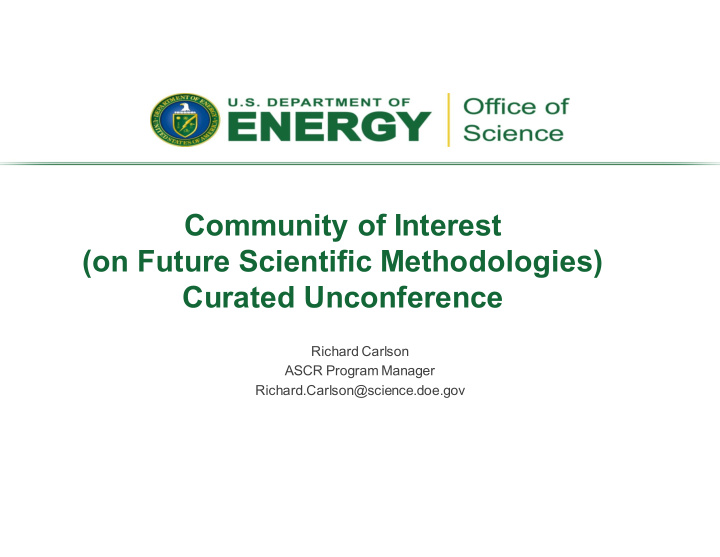



Community of Interest (on Future Scientific Methodologies) Curated Unconference Richard Carlson ASCR Program Manager Richard.Carlson@science.doe.gov
Welcome
Purpose This curated unconference is focused on you and your peers putting aside your day-to-day job and instead exploring what Computing in the DOE Lab complex might look like in 2050
Why are you Here? � Goals or Objectives � Non Goals or Objectives � Strategic Thinking about � Tactical Thinking about possible futures solving todays problems � Multiple Ideas and � Basic Research Needs or possible technologies Priorities � Explore each idea in � Technologies that will have depth short term impact
Examples: Ideas that required 30+ years � In 1874 the idea that man � In 1939 few thought man would fly was not widespread would walk on the moon � Yet Balloons had been used for � Yet rockets had been around for almost a century centuries � By 1883 Several scientists and � J�le� Ve��e ����e �F��� �he engineers were studying the Earth to the Moon: A Direct problem R���e i� 97 H����, 20 Mi���e�� in 1865 � Octave Chaunte � Otto Lilienthal � By 1938 Robert Goddard had � Louis Bleriot successfully developed a liquid- fueled rocket � On December 17, 1903 the Wright Brothers made 4 powered flights � On July 20, 1969 Apollo 11 � Eagle landed on the moon
I want/need an Airplane � Day 1 � I�m going �o e�pand on �he pre�io�s slide �o gi�e �he gro�p some addi�ional thoughts on how to make this workshop productive. 1. Each breakout group needs to identify a 30 year goal or objective for something that does not exist yet. In this example in 1874 the ask is: I want an Airplane capable of carrying a human over some distance! 2. The next step is to identify some implications of that device, technology, object, methodology. Some potential implications of a workable airplane are: � People can travel long distances in a single day (international meetings) � Packages and goods can move long distances (Oranges delivered to AK in winter)
I want/need an Airplane � Day 2 � Now that we know what the goal is, and the implications of that, Day 2 starts getting into more details. How do we know that progress is being made towards reaching that goal? 1. The next step is to develop a timeline with signposts that allow us to track progress (think about interstate signs that tell you which major city is x miles away: � 20 years out the materials being used to build the airplane need to be readily available � 20 years out the skilled craftsman need to be able to shape this material into structures � 10 years out the math required to define the coefficient of Lift and Drag need to be experimentally verified � 5 years out the ability to build an engine with enough power and low weight needs to exist 2. The next step is to rank order these signposts and determine how likely they will be meet in the required timeframe: � The airplane structure will be wood (spruce) with a fabric covering. Highly probable that the material and knowledge to fabricate the airplane will exist when needed � Engine performance and weight needs to be improved, applied research is required � Wind tunnel experiments and kite flying experiments produce different results, requiring basic research
I want/need an Airplane � Day 3 � Now that we have the overall goal and some idea of what research activities are needed (but not specifics on how to do that), Day 3 explores how things could fail horribly or succeed beyond your wildest dreams. 1. Now think about the possible pitfalls and roadblocks that could stymie your progress: � The engine is not powerful enough to push the plane forward fast enough to allow it go generate enough lift � The shape of the propeller is wrong so it doesn�t provide the right amount of thrust � Inadequate funding prevents the PI from conducting experiments. 2. Lastly, how can success be measured. Not just the final product, but incremental milestones that can show we will have a workable airplane in 30 years, also consider spin- off technologies that are used in other places/ways: � We have an airplane that can take-off, land, and is controllable in flight � Engines are used in cars as well as airplanes � The postal service uses airplanes to ship mail around the country in days not months
Daniel Burnham Quote Make no little plans. They have no magic to stir men�s blood
Recommend
More recommend